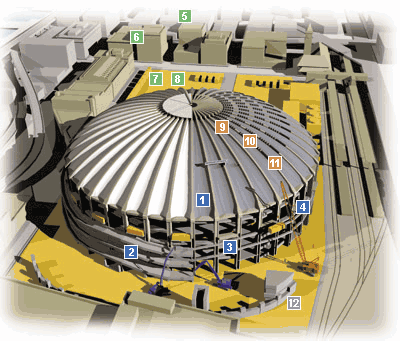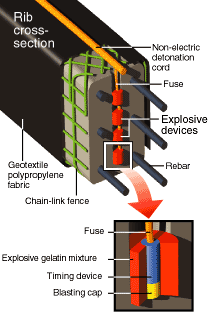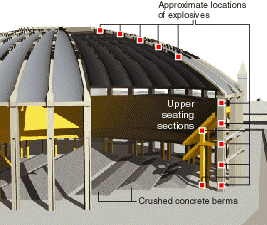
Stripping the Dome
 Removing roofing material
Removing roofing material
Two backhoe-like machines, called mini-maxes, stripped approximately 400
square feet of the 6-inch-thick layer of roof surface and insulation so only
bare concrete remains.
 Removing air-conditioning units
Removing air-conditioning units
The boxcar-size units were removed one at a time by crane and then stacked
on the perimeter of the work site, forming a partial barrier for the
implosion.
 Demolishing exterior ramps
Demolishing exterior ramps
Using a combination of small excavators at the upper levels and larger
machinery on the ground level, the ramps encircling the Dome were removed in
portions. The concrete shaft and metal walls were removed from the top down,
leaving the large supporting columns intact.
 Demolishing lower-level seating sections
Demolishing lower-level seating sections
Labor crews, using loaders and mini-excavators, removed all non-concrete
material from inside, separating recyclables from landfill debris. Concrete
supporting the lower-tier seats was broken into rubble and spread over the
field to help cushion the impact of the implosion.
Back to top
Cushioning the neighborhood
 Wrapping and sealing nearby buildings
Wrapping and sealing nearby buildings
Nearby buildings will be protected in various manners depending on their
structure and proximity to the Dome. Measures may include sealing air-handling
units, taping seams on doors and windows, covering doors and windows with
plywood, and draping reinforced polyethylene sheeting and geotextile fabric
around the outside. Property owners will be provided with polyethylene sheeting
to protect interiors.
 Erecting protective walls and berms
Erecting protective walls and berms
Barriers were erected by stacking the air conditioning units and other materials
on the perimeter of the work area. Rubble piles will also help absorb the
impact.
 Establishing a restricted zone and evacuating people and pets
Establishing a restricted zone and evacuating people and pets
An area extending roughly 1,000 feet from the Dome will be off-limits to people
during the time of the implosion; a larger area will be closed to traffic.
Accommodations will be provided for people and pets who live within the
restricted zone.
 Dust control and repairs after the implosion
Dust control and repairs after the implosion
Eight water trucks, eight sweeper units and more than 100 workers will be
deployed immediately following the blast to clean up dust. Any larger repairs
will be tended to as soon as possible.
Back to top
Rigging the explosives
 Drilling holes for explosives
Drilling holes for explosives
About 6,000 holes, each 1 3/4 inches in diameter and 5 to 6 feet deep, were
drilled in the ribs of the roof and in the support columns. The rolling
gantry originally intended for roof maintenance was used to drill holes in
the ribs as well as to assist in stripping the roofing material.
 Packing and wrapping explosives
Packing and wrapping explosives
Each of the drill holes is numbered and packed with a specific amount of
explosive with a timing device set with a delay. Each hole is then wrapped
in a layer of chain-link fencing covered with geotextile polypropylene
fabric. The wrapping material is intended to expand with the blast and
contain debris.

 Stringing detonation cord and setting timing devices
Stringing detonation cord and setting timing devices
100,000 feet of non-electric detonation cord, which burns at 24,000 feet
per second, will run around the Dome's ribs and columns, connecting all of
the explosives. A combination of surface delays in between the rows of
detonation cords and timing devices will create the correct sequence of
explosions to bring down the Dome.
 New stadium started
New stadium started
Construction has begun on south walls and stairwells of new football
stadium.
Back to top
Inside the Dome
Work crews have demolished much of the interior, including the lower seating
sections. The upper sections will have explosives placed in supporting
columns and will come down with the implosion.
The rubble from the lower sections and other areas of demolition has been
spread out in berms across the floor of the Dome to absorb some of the
impact of the falling roof.

Back to top
Graphics and text: Phil Loubere; Reporting and text: Whitney Stensrud; Reporting: Jeff Hodson / © 2000 The Seattle Times


